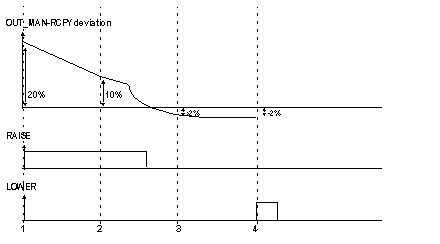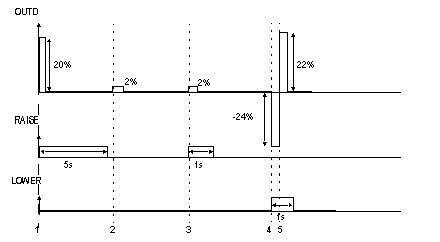|
Operating Process Examples of the Servo Function
|
|
|
(Original Document)
|

|
Step
|
Operating principle
|
|---|---|
|
1
|
The deviation between OUT_MAN and RCPY is 20%. A pulse of 5 s (25 s x 20%) is generated on the RAISE output.
|
|
2
|
The deviation is 10%. A pulse of 2.5 s (25 s x 10%) is generated on the Raise output, without accounting for the second which remained from the previous pulse.
|
|
3
|
The deviation is –2%, which would correspond to a pulse of 0.5 s (25 s x 2%) on the LOWER output. As T_MINI equals 1 s, no pulse is generated (in contrast, the 0.5 s duration is stored.
|
|
4
|
The deviation is always -2%. The corresponding pulse (0.5 s) is added to the previously stored pulse (0.5 s) to give 1 s. As this duration is at least equal to T_MINI, the pulse is therefore applied to the LOWER output.
|

|
Step
|
Operating principle
|
|---|---|
|
1
|
The PID output variation is +20%. A pulse of 5 s (25 s x 20%) is generated on the RAISE output.
|
|
2
|
The PID variation is +2%, which would correspond to a pulse of 0.5 s. As this pulse is less than T_MINI (=1 s.),it does not affect the outputs.
|
|
3
|
This second PID output variation is +2%. In order to be calculated, the function adds this variation to the previous variation (which was below the minimum value), corresponding to a global variation of +4%. A pulse of 1 s (25 s x 4%) is generated on the RAISE output.
|
|
4
|
The PID output variation is -24%. A pulse of 6 s (25 s x 24%) is generated on the LOWER output.
|
|
5
|
Before completion of the following second, a further variation of +22% on the PID output restores the system to a global variation of –2%. As this variation corresponds to a pulse of 0.5 s (below T_MINI), the function ends by carrying out the minimum pulse of 1 s.
|